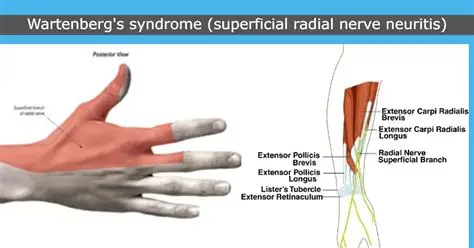What is Wartenberg’s Syndrome?
Wartenberg’s syndrome, also known as radial nerve entrapment or Cheiralgia Paresthetica, is a medical condition characterized by pain, numbness, and tingling in the hand and fingers, specifically the thumb, index, and middle fingers. The syndrome is caused by compression or irritation of the radial nerve as it passes through a narrow passage in the forearm called the radial tunnel.
Symptoms OF Wartenberg’s Syndrome
The symptoms of Wartenberg’s syndrome vary from patient to patient, a few of them are mentioned below:
- Pain or discomfort in the forearm, wrist, and hand.
- Numbness or tingling in the thumb, index, and middle fingers.
- Weakness in the hand and difficulty in gripping or holding objects.
- In severe cases, the hand may have muscle wasting.
Pathology:Wartenberg’s Syndrome deformity occurs when there is an imbalance between the forces acting on the inner and outer aspects of the knee joint, causing the knee joint to tilt towards the midline of the body. This leads to increased pressure on the inner aspect of the knee joint and can cause the development of arthritis over time. In addition, the abnormal alignment of the legs can cause strain on the muscles and ligaments, leading to pain and instability in the knee joint.
Causes of Wartenberg’s Syndrome
The causes of Wartenberg’s syndrome can be varied, it usually occurs due to closed injury, some other common causes include:
- Repetitive use of the wrist and forearm, such as in certain occupational or sports activities.
- Direct trauma to the wrist or forearm, such as from a fall or impact.
- Inflammation or swelling of the radial nerve due to underlying medical conditions like arthritis, diabetes, or thyroid dysfunction.
- Anatomic variations in the radial tunnel that increase the pressure on the nerve.
Pathology: Wartenberg’s syndrome is caused by compression or irritation of the radial nerve as it passes through the radial tunnel, a narrow passage formed by the forearm's bones, muscles, and ligaments. Repetitive use of the wrist and forearm, direct trauma to the area, inflammation or swelling of the nerve, or anatomic variations that increase pressure on the nerve can all contribute to the development of Wartenberg’s syndrome. As the radial nerve is compressed, it may become inflamed and swollen, further exacerbating pain, numbness, and tingling symptoms.
Diagnosis Of Wartenberg’s Syndrome
Physical examination: The therapist performs a physical examination to assess for signs of nerve compression, such as pain, weakness, numbness, or tingling in the hand and fingers. They may also assess for any muscle wasting or atrophy.
Imaging studies: Imaging studies such as X-rays, MRI, or CT scans may be ordered to assess for any anatomic variations or abnormalities that may be contributing to nerve compression.
Medical history: The physiotherapist asks about the patient's symptoms, medical history, and any factors that may contribute to the development of Wartenberg’s syndrome, such as repetitive use of the wrist or forearm, trauma, or underlying medical conditions.
Nerve conduction studies:This test assesses the speed and strength of electrical signals transmitted through the radial nerve. It can help confirm the diagnosis of Wartenberg’s syndrome and assess the severity of the condition.
Treatment Of Wartenberg’s Syndrome
Medications: Nonsteroidal anti-inflammatory drugs (NSAIDs), Corticosteroids, Anticonvulsants, Muscle relaxants, etc.
Note: Medication should not be taken without the doctor’s prescription.
Physiotherapy Treatment Of Wartenberg’s Syndrome
Cryotherapy: Cryotherapy or cold therapy can help reduce inflammation and pain.
Thermotherapy: Thermotherapy or heat therapy can help promote blood flow and tissue healing.
Ultrasound therapy: Ultrasound therapy involves the use of high-frequency sound waves to stimulate blood flow and promote tissue healing. This modality may be used to reduce inflammation and pain in the affected area.
Transcutaneous Electrical Nerve Stimulation (TENS): TENS involves the use of a small device that delivers low-voltage electrical current to the affected area via electrodes placed on the skin. TENS can help reduce pain and improve nerve function in patients with Wartenberg’s syndrome.
Electrical muscle stimulation (EMS): EMS involves the use of electrical impulses to stimulate muscle contractions. This modality may be used to help maintain muscle strength and reduce muscle wasting in the affected hand.
Shortwave diathermy: Shortwave diathermy involves the use of high-frequency electromagnetic waves to generate heat in the affected area. This modality may be used to promote tissue healing and reduce pain and inflammation.
Range of motion exercises: Range of motion exercises is designed to improve the flexibility and mobility of the affected hand and wrist. These exercises may include wrist rotations, finger stretches, and grip-strengthening exercises.
Nerve gliding exercises: Nerve gliding exercises involve moving the affected nerve through a range of motion to reduce compression and irritation. These exercises may include wrist extensions, finger extensions, and elbow flexion.
Soft tissue mobilization: Soft tissue mobilization techniques such as massage, myofascial release, and trigger point therapy can help reduce muscle tension and promote tissue healing.
Patient Education
Patients should be instructed to prevent further injury to the affected hand and wrist, such as avoiding repetitive motions, using proper ergonomics, and wearing supportive braces or splints. Patients should be encouraged to maintain a healthy lifestyle, including getting regular exercise, eating a balanced diet, getting enough rest, and avoiding smoking and excessive alcohol consumption.


